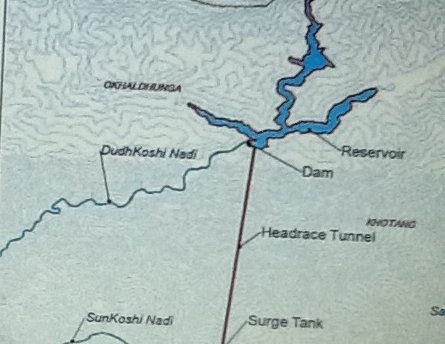
It was indeed a great historic achievement that our then government was able to convince India to revise in 1966 the Kosi Treaty. The revised treaty has granted our country absolute right to use the entire water of the Sun-Kosi basin for irrigation in our Terai. The total dry season flow of the Sun-Kosi including the flow of the Dudh-Kosi river is needed to meet the demand for irrigation of the Eastern Terai region extending from Kosi river to Parsa in the west.
It is reported in local newspaper that the NEA (Nepal Electricity Authority) is going to implement the Dudh-Kosi dam project to generate electricity. It would be quite horrific if our own institution, the NEA greatly praised for resolving present energy supply problem, implements the Dudh-Kosi dam project to generate energy that would completely ruin the potential of the Dudh-Kosi river to irrigate our eastern Terai.
The 1966 Revision of Kosi Treaty
The Gandak River Treaty signed between Nepal and India in 1959 had completely curtailed our country’s right to use freely the water of rivers in Gandak basin within our territory except in three months of the monsoon season when all Gandak tributaries are in full spate. There was a widespread condemnation of that Treaty within Nepal. Few years later our country started serious negotiations with India to revise the Gandak and Kosi treaties.
Very few know about the revision of the Gandak and Kosi treaties. The Gandak Treaty was revised in 1964. After this revision the restriction imposed on use of Gandak water in Nepalese territory has been considerably relaxed. Next, our then government succeeded in securing the revision of the Kosi Treaty. The 1966 revised Kosi Treaty is a landmark treaty entitling Nepal absolute right to use the entire water of the Sun-Kosi and the Kosi river in whatever way Nepal may wish. Thus, India has without any reservation recognized Nepal’s absolute right to use the entire flow of the Kosi and its tributaries.
Surprisingly, there is still a hangover of the bad feeling among most of Nepalese from the 1959 Gandak Treaty biased against Nepal’s legitimate right. Still people suspect foul-play in Kosi Treaty.
Indian Recognition of Nepal’s Absolute Right
The Clause 4 of the revised Kosi Treaty guarantees Nepal’s absolute right to use the entire water of the Kosi: Clause4 - HMG shall have every right to withdraw for irrigation and for any other purpose in Nepal water from the Kosi river and from the Sun-Kosi river or within the Kosi basin from any other tributaries of the Kosi river as may be required from time to time. The Union (India) shall have the right to regulate all the balance of supplies in the Kosi river at the barrage site thus available from time to time and to generate power in the Eastern Canal.
Thus the revised treaty allows Nepal to draw for irrigation or any other purposes the entire flow of the Kosi even to the extent of drying up the river and virtually to cut off totally the water supply to the existing Kosi barrage and also to any other barrages to be built in India in future. It should be remembered that Nepal would have to use for irrigation the entire dry season flow of the Sun-Kosi and Dudh-Kosi river if multipurpose storage dams are not built to augment the dry season discharge.
Sun-Kosi Dam Site
The site of the Sun-Kosi dam to be built for diverting the entire flow of this river onto Terai plain had been identified based on several past studies. The dam site is located just downstream of the confluence of the Sun-Kosi and the Dudh-Kosi rivers that would allow the diversion of both these rivers. The place is called KURULE. Renowned expert on Himalayan geology Dr. J.B. Auden was initially involved in selection of this dam site,
The first technical team investigating the Kurule dam site in 1947 was led by renowned hydraulics expert Dr. N.K. Khosla from the Government of India. The team found this site to be suitable for building even a high dam.
The idea of diverting Sun-Kosi for irrigation in Terai was first put forward in 1968. This study was conducted under UNDP/FAO assistance. The study had identified Kurule as the appropriate site for diversion of the entire flow of the Sun-Kosi river including the Dudh-Kosi flow onto Terai.
A Master Plan study on the Kosi river water resources was prepared by JICA technical team in 1985. The study has identified Kurule as the site for the diversion of the Sun-Kosi onto Terai.
Killing Dudh-Kosi Irrigation Potential
The entire dry season flow of the Sun-Kosi and also the Dudh-Kosi river must be diverted onto Terai if the vast area of the Eastern Terai from Parsa district to Kosi river is to be irrigated as envisaged in the FAO/UNDP supported study. Unfortunately the proposed Dudh-Kosi dam project would be drawing Dudh-Kosi river water for power generation from a point upstream Kurule (the confluence point of the Sun-Kosi and Dudh-Kosi river) and discharging it back into to Sun-Kosi further downstream the Sun-Kosi dam site at Kurule. Thus the Dudh-Kosi river water would be completely out of reach for irrigation in Eastern Terai.

Dr. A.B. Thapa
Thapa writes on water resources issue
- Dudhkosi Multipurpose Project
- Jul 11, 2022
- Dudh-Kosi Power Project And Kosi Treaty
- Sep 27, 2021
- Uttarakhand Glaciers And Recent Disaster: A Lesson To Our Country
- Mar 02, 2021
- Multipurpose Langtang After Melamchi: Inter-Basin Water Transfer
- Nov 04, 2020
- Large Storage Dams Projects Wary of Giving Away Children’s Inheritance
- Dec 22, 2019












